
* The Model 309 KingCobra had featured TOW missile armament, and would lead to a new generation of AH-1 Cobras with such weaponry. The US Marines would go a step further and acquire Cobras armed with the more effective Hellfire antitank missile. These second-generation Cobras would see extensive service in the dirty little wars that followed the collapse of the Soviet Union, as well as with a number of foreign armies. In its latest "AH-1Z" incarnation, the Cobra remains in first-line service in the 21st century.
* In December 1971, Bell signed a contract for $708 million USD with Iran to deliver 287 Model 214 Huey utility helicopters, and 202 improved AH-IJ Cobra gunships. The improved Cobra, known as the "International AH-1J", that resulted from this contract featured an uprated P&WC T400-WV-402 engine and stronger drive train to support 1,250 kW (1,675 SHP) continuous. Recoil damping gear was fitted to the 20-millimeter gun turret, and the gunner was given a stabilized sight and even a stabilized chair.
62 of the International AH-1Js delivered to the Shah's forces were TOW-capable, leveraging off the work done on TOW carriage for the KingCobra, while the rest were not. Bell also delivered eight TOW-capable International AH-1Js to South Korea in 1978.
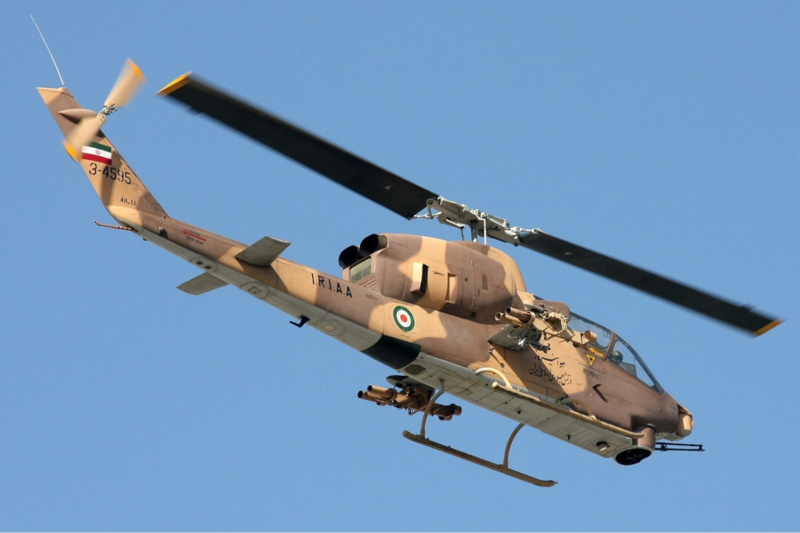
Iranian Cobras saw extensive combat in the war with Iraq in the 1980s, most notably coming up against their "opposite number", the Soviet-built Mil-24 "Hind" gunship. The Hind was more powerful and faster than the Cobra, but the Cobra was more agile, and the two machines were fairly evenly matched in a "dogfight". The Iranians claimed six Cobra "kills" on Hinds, often using the TOW, while the Iraqis claimed ten "kills" on Cobras in return. The Iranians even claimed that Cobras shot down three Iraqi MiG-21 jet fighters.
Due to weapons embargoes, the Iranians had to make do with what was at hand, and apparently Iranian International AH-1Js were fitted with the AGM-65 Maverick missile, and used it with some success. However, the war was hard on the Iranian Cobra force, with about half of it lost during the conflict from combat, accidents, and simple wear and tear.
The Iranians have done fairly well at keeping the survivors in service and have shown off some upgrades, with flat-plate cockpits (more on this below), a radar warning receiver system, Global Positioning System (GPS) navigation, a FLIR, and a "glass cockpit" with a large multifunction display (MFD) for each station. In 2012, they even unveiled their own copy of the Cobra, the "Toufan 2", with all the latest systems -- though there was skepticism that the Iranians were doing any more than just updating their old Cobras.
BACK_TO_TOP* Although the US Army had selected the AH-64 to deal with hordes of Red armor, the Apache was not going to be ready for some time. Once more, the Army turned toward the Cobra as the "interim solution".
In March 1972, the service requested that Bell investigate arming the existing AH-1G with the TOW missile under the "Improved Cobra Armament Program (ICAP)". Bell promptly fitted eight AH-1Gs with the new Bell-Hughes XM26 "Telescopic Sighting Unit (TSU)" in the nose, and two M56 four-pack TOW launchers. The M56 launchers were fitted to the outboard pylons, while the inboard pylon could still accommodate an unguided rocket pod or other stores. In some cases, twin-tube TOW launchers were fitted instead of quad-tube launchers, but this seems to have been an unusual fit. These eight Cobras were redesignated "YAH-1Q", and performed a long series of TOW test firings from early 1973 through early 1975.
The Army felt the YAH-1Q met their short-term needs, and ordered conversion of 101 AH-1Gs to the "production" AH-1Q "TOWCobra" configuration, featuring the M56 TOW launchers, the M65 production version of the M26 TSU. The first AH-1Q was delivered to the Army in early 1975.
* Even as the AH-1Q was going into operation, however, everyone realized it didn't have the power to carry the heavy quad TOW launchers and still easily perform NOE maneuvers. In 1975, the Army began the "Improved Cobra Agility & Maneuverability (ICAM)" program to address this problem. Bell fitted an AH-1G with an uprated Lycoming T53-L-703 turboshaft with 1,340 kW (1,800 SHP) and a new drive train, with the result redesignated the "YAH-1R". An AH-1Q was converted to a similar configuration, and redesignated the "YAH-1S".
The new engine fit was satisfactory, and the Army ordered conversion of all 92 surviving AH-1Qs, plus 198 AH-1Gs, to the new configuration, with minor additional refinements such as the "sugar scoop" exhaust deflector. They were variously known as the "Improved AH-1S", "AH-1S Modified", or "AH-1S(MOD)", to be blessedly redesignated "AH-1S" in 1988. For convenience, this variant is simply referred to as "AH-1S" in the following discussion.
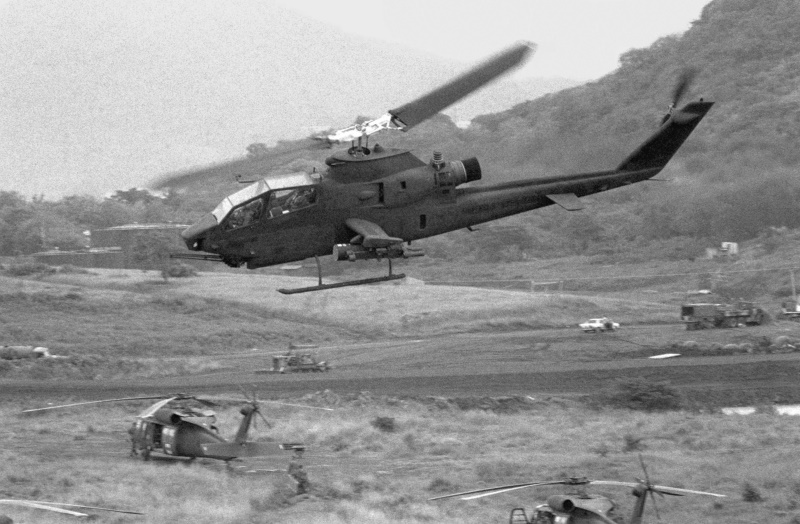
The last AH-1S conversion was delivered in early 1979. Fifteen of the AH-1S Cobras were converted by Northrop to specialized "TH-1S" trainers in the mid-1980s. The gun turret was removed and replaced with a plug, and they were fitted with the "Passive Night Vision System (PNVS)" from the AH-64 Apache and blackout curtains for the pilot. They were intended to be used to train Apache pilots in night landing techniques.
* The AH-1S led to a series of TOWCobra refinements, or "Steps". The "Step 1" variant was the new-build "Production AH-1S" or "AH-1S(PROD)", which was redesignated "AH-1P" in 1988.
100 AH-1P TOWCobras were built and delivered to the Army in 1977 and 1978. They featured a still further uprated engine system, as well as a distinctive new "flat plate" canopy. Although the new canopy gave the Cobra a more businesslike "flying tank" look, the change was made to reduce the glint off the window glass and did not feature armor glass.
The AH-1P also featured an updated instrument panel for NOE flight; a radar altimeter and improved radios; an AN/APR-39 radar warning receiver; and, from the 67th production unit onward, Kaman K-747 composite rotor blades with tapered tips. The K-747 rotor blades were retrofitted to older Cobra variants. Some of the gunships were temporarily refitted with metal blades in the mid-1980s, when a few K-747 composite blades lost their tips due to bonding problems, but that issue was quickly resolved.
* The "Step 2" variant was originally known as the "Up-Gun AH-1S", "AH-1S Enhanced Cobra Armament System", or "AH-1S(ECAS)", but was redesignated as "AH-1E" in 1988. While all Army Cobra variants to this time retained the old TAT-141 turret, the AH-1E featured the three-barrel 20-millimeter M197 cannon and universal turret introduced on the Marine AH-1J. The AH-1E also featured:
98 new-built AH-1Es were delivered in 1978 and 1979.
* The "Step 3" variant was originally designated the "Modernized AH-1S", "AH-1S Modernized Cobra", or "AH-1S(MC)", but was redesignated "AH-1F" in 1988. It was the US Army's final operational standard for the Cobra gunship.
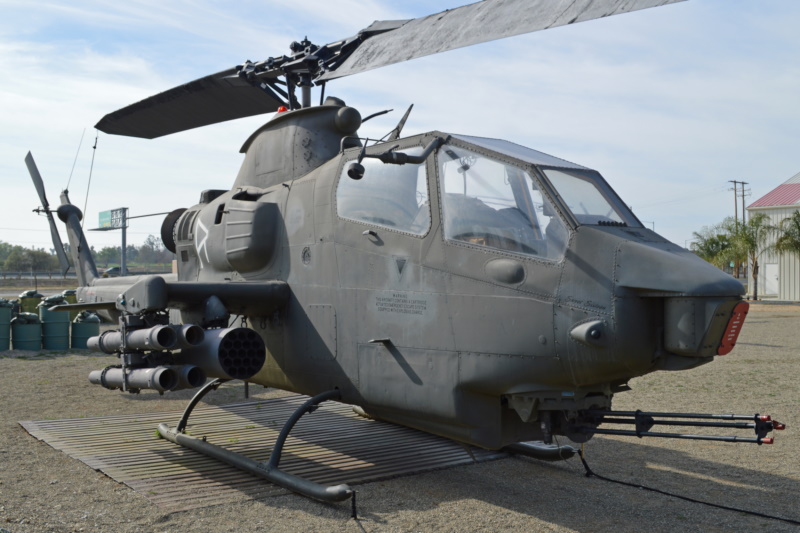
The AH-1F featured all the improvements of the AH-1P and the AH-1E, along with numerous refinements. The AH-1F featured:
___________________________________________________________________
BELL AH-1F TOWCOBRA:
___________________________________________________________________
rotor diameter:
13.4 meters (44 feet)
fuselage length:
13.6 meters (44 feet 7 inches)
footprint length::
16.2 meters (53 feet 1 inch)
height:
4.09 meters (13 feet 5 inches)
empty weight:
2,995 kilograms (6,600 pounds)
max loaded weight:
4,535 kilograms (10,000 pounds)
maximum speed:
225 KPH (14O MPH / 120 KT)
service ceiling:
3,720 meters (12,200 feet)
hover ceiling (in ground effect):
3,720 meters (12,200 feet)
range:
510 kilometers (315 MI / 275 NMI)
___________________________________________________________________
Two AH-1Ps were converted to AH-1F prototypes. 99 new-build AH-1Fs were built for the US Army and 50 were built for the US Army National Guard (ANG) from 1979 through 1986, which were the last new-build single-engine Cobras manufactured for the US. In 1986, the US Army had 1,100 Cobras in inventory. 378 AH-1Gs were also converted to AH-1F specification from 1979 through 1982, including 41 dual-control TAH-1F trainers.
* The AH-1F was the focus of small and incremental updates, such as a new engine air filter; improved rotor swashplate; laser warning sensor; Stinger air to air missile (AAM) support; and the "Cobra Night Attack (C-NITE)" system, which gave the gunship a day-night, all weather TOW capability.
However, the machine was still becoming increasingly outdated. By the late 1980s the AH-64 Apache was replacing the Cobra in frontline service, with Cobras increasingly passed on to Army National Guard units. The Cobra was finally phased out of US Army combat service in 1999, and was phased out of National Guard service in 2001. A few lingered in Army service in specialized roles: two were converted to drone configuration to experiment with robot gunships, and there was talk of using the old AH-IFs as target drones.
Some Cobras were passed on to foreign users, and 25 were passed on to the US Forest Service (USFS), to be refitted with a FLIR turret under the nose, equipped with a datalink, and painted in spiffy red and white colors. The first went into service in late 2003. The USFS used the "FireCobra", to invent a name for it, in mapping out fires and directing fire-fighting crews. Although these machines were not used to drop water or retardant, the Florida Forestries Agency also operated three old AH-1Ps in that role, with each machine carrying an external bucket, or a tank system plugged into the space left over from the cannon system. The FireCobras were finally retired in 2021.
BACK_TO_TOP* While only 69 examples of the USMC AH-1J SeaCobra were built, the service had planned to acquire 124. The reason for the small buy was that the Marines wanted TOW capability and more power, and midway through planned production two AH-1Js were converted to prototypes of a new SeaCobra variant, the "AH-1T". The first AH-1T prototype flew on 20 May 1976 and proved very satisfactory.
The AH-1T featured a new P&WC T400-WV-402 Twin Pac engine with 1,470 kW (1,970 SHP), plus a new transmission system taken from the Bell 214, a bigger 14.6 meter (48 foot) rotor with wider chord and swept tips, plus a bigger tail rotor. The tailboom was lengthened to accommodate the new rotor system, resulting in a visible "kink" where the tailboom joined the fuselage. The forward fuselage was extended slightly as well to balance the longer tailboom, with the additional space allocated to increased fuel tankage. The AH-1T also had a small ventral fin.
A total of 59 production AH-1Ts was built. Due to funding problems, the first 33 did not have TOW capability, but the last 24 were fitted with nose sights and Sperry-Univac helmet-mounted sights for TOW compatibility, and the survivors of the first 33 were eventually brought up to this standard. Modifications were later added to allow them to carry the Hellfire missile.
* In the late 1970s, Bell considered the AH-1T design as the basis for a new Cobra variant to be sold to Iran, and developed a prototype of an "AH-1T+" with twin GE T700-GE-700 providing 940 kW (1,258 SHP) each and Hellfire capability. The fall of the Shah eliminated all prospects of a sale, but Bell did not abandon the effort, flying the AH-1T+ demonstrator in April 1980. This was something of an exercise in faith, since the most likely remaining customer, the US Marine Corps, really wanted to buy the AH-64 Apache. However, Bell's gamble paid off, since in 1981 Congress refused to provide funding for the Apaches, and the Marines were forced to settle for "yet another warmed-over Cobra".
Bell was determined to give the Marines their money's worth, and reworked the AH-1T+ with a more powerful dual GE T700-GE-401 turboshaft power pack providing a total of 2,520 kW (3,380 SHP) and a range of other improvements. The resulting "SuperCobra" prototype was first flown on 16 November 1983, painted with a gold cobra running down its length. The production machine was redesignated "AH-1W". An initial order for 44 and a single TAH-1W trainer was followed by an additional order for 34, and 39 surviving AH-1Ts were upgraded to the AH-1W specification.
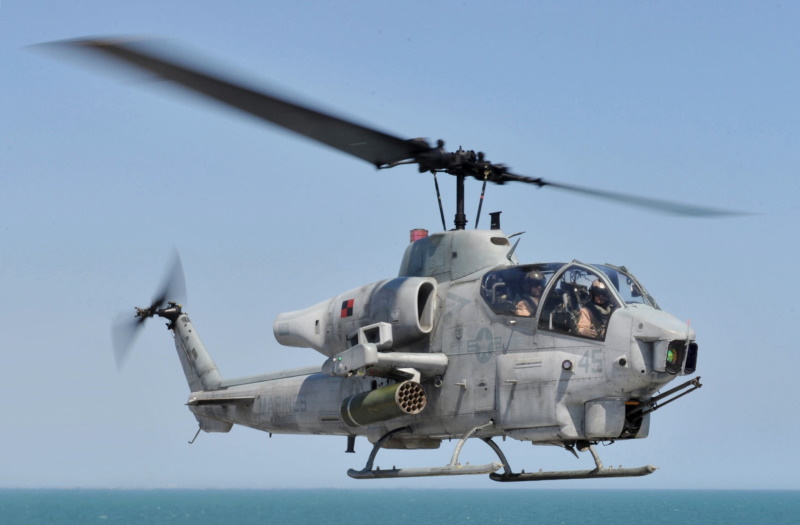
Along with the new engine system, the "Whiskey Cobra" featured:
The AH-1W was qualified for a large number of stores, including TOW; Hellfire; the AIM-9L Sidewinder AAM; and the AGM-122 SideARM anti-radar missile, which was just an old AIM-9C Sidewinder with an anti-radar seeker. 290-liter (77 US gallon) external tanks were also carried, while "iron bombs" and cluster bomb units were qualified, though not used in practice. The Marines also qualified a new "armor piercing sabot discarding (APSD)" round for the M197 cannon to enhance its lethality against armored vehicles.
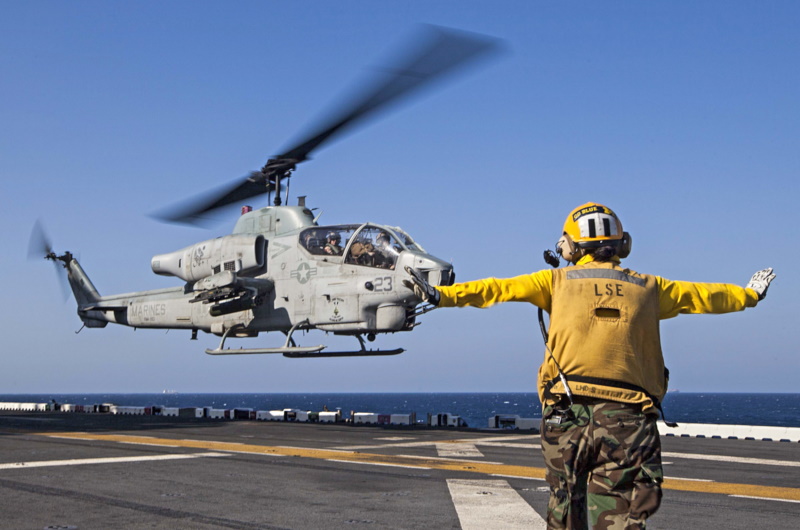
The Hellfire, with its increased range and ability to kill the toughest armor, was a big step over the old TOW and gave the AH-1W a much meaner punch. The Sidewinder and Sidearm were rarely if ever used operationally. The Sidewinder was a big and clumsy store, and it was never really needed much in practice. The smaller Stinger and Starstreak AAMs, carried by other helicopters, would have been much more useful but were never put into service with the AH-1W, though it appears the Stinger was qualified.
___________________________________________________________________
BELL AH-1W SUPERCOBRA:
___________________________________________________________________
rotor diameter:
14.6 meters (48 feet)
fuselage length:
13.9 meters (45 feet 6 inches)
footprint length:
17.68 meters (58 feet)
height:
4.44 meters (14 feet 7 inches)
empty weight:
4,950 kilograms (10,920 pounds)
max loaded weight:
6,690 kilograms (14,750 pounds)
maximum speed:
278 KPH (173 MPH / 150 KT)
service ceiling:
4,270 meters (14,700 feet)
hover ceiling (in ground effect):
4,500 meters (14,750 feet)
hover ceiling (out of ground effect):
915 meters (3,000 feet)
range:
518 kilometers (322 MI / 280 NMI)
___________________________________________________________________
BACK_TO_TOP
* The AH-1T that was modified to the AH-1T+ demonstrator and AH-1W prototype was later fitted with an advanced composite four-bladed rotor system that provided better performance, less noise, and greater resistance to battle damage. This "Four Bladed Whiskey (4BW)" Cobra didn't lead immediately to a production contract and the rotorcraft was returned to Marine service in a normal AH-1W configuration, but Bell continued work on the concept.
The 4BW was part of a long series of advanced Cobra proposals, featuring such items as a four-bladed rotor, improved engines, improved avionics, and improved weaponry. A "Model 249" demonstrator was rebuilt from the original YAH-1S prototype to test out these concepts. Proposals included a "PAH-2" Cobra for European sales, with armament of eight Euromissile HOT antitank missiles, and other advanced concepts such as the "Cobra 2000" and the "CobraVenom". The US Marines finally bit, signing a contract with Bell in 1996 to upgrade 180 AH-1W SuperCobras to the "AH-1Z" standard for service in the 21st century.
* As introduced, the "Zulu Cobra" AKA "Viper" featured a new, quieter four-blade composite rotor with an automatic folding mechanism to make the helicopter easy to store on ship, a 10,000-hour lifetime, and the ability to survive hits by 23- millimeter projectiles. A four-blade tail rotor was also fitted. The T700-GE-410 Twin Pac used on the Whiskey Cobra was retained, but the Zulu Cobra featured an uprated gearbox and transmission, fitted in a reprofiled fairing.
A new Hamilton Sundstrand auxiliary power unit (APU) was fitted, the same type as used on the Sikorsky S-70 Black Hawk helicopter. Fuel capacity was increased by 758 liters (200 US gallons), partly by using a "wet" wing with fuel storage. The fuel tanks were filled with inert gas to reduce fire hazard.
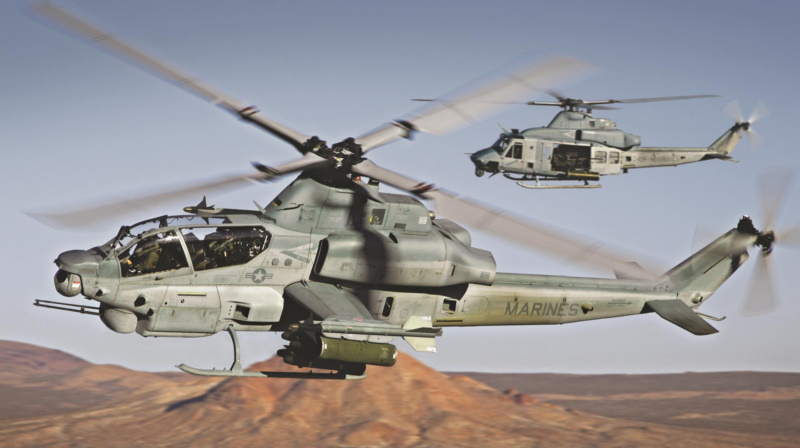
The AH-1Z upgrade also increased stores capability to six wing stations, including two wingtip stations for missiles like the Sidewinder, and four for unguided rocket packs, or TOW / Hellfire quad missile launchers. The Zulu Cobra could carry the Longbow millimeter-wave all-weather targeting radar for the AGM-114L Hellfire variant, with a radar pod mounted on the right wingtip. The Marines have also adopted the Advanced Precision Kill Weapons System (APKWS), a 70-millimeter rocket with a laser guidance module, on the AH-1Z.
Cockpit and avionics were upgraded as well. The cockpit was completely redesigned, with switches conveniently arranged and "hands on collective and stick (HOCAS)" flight controls. Other features included two multifunction 15 by 20 centimeter (6 by 8 inch) flat-panel displays for each crewman, with digital map display capability; secure radio communications; a tactical digital data system; and an inertial-navigation system incorporating a GPS receiver. Both sets of cockpit controls were largely identical, allowing either crewperson to fly the helicopter or fire its weapons. A rudimentary backup cockpit flight-control panel operated off battery power was also provided for each crewperson so that the AH-1Z could "limp home" if its AC power system was disabled.
The AH-1Z was fitted with a nose-mounted AN/AAQ-30 "Hawkeye" Target Sighting System (TSS), featuring a FLIR imager, low-level-light color zoom TV, a laser rangefinder, and an "eye-safe" laser target designator. Earlier FLIRs didn't have the range to allow combat crews to identify a target from more than a few kilometers away, but the third-generation FLIR used in the TSS had large-aperture optics and a highly effective stabilization system, allowing target identification from beyond the range of the Hellfire missile, indeed from beyond the range of most battlefield air-defense weapons.
Zulu Cobra flightcrews were provided with advanced "TopOwl" flight helmets developed by Thales of France as one of the core elements of the flight system. The helmet featured a high-resolution projection TV system that could display flight or targeting data and imagery on the visor in a "see-through" fashion, and also could be fitted with snap-in cameras to provide a highly integrated night-vision capability. The helmet weighed only 2.2 kilograms (4.8 pounds) with the cameras in place.
Other system enhancements included a new self-defense suite, airborne target handoff system, an onboard systems monitor, two mission computers, and a mission data loader. The self-defense suite included four AN/ALE-47 chaff-flare dispensers, replacing the two AN/ALE-39s on the Whiskey Cobras. The AN/ALE-47 could be set to manual, semiautomatic, or fully automatic modes. An improved AN/APR-39B(V)2 radar warning receiver was fitted, as well as an updated AN/AAR-47(V)2 missile warning unit, which also provided laser warning and replaced the old AN/AVR-2 unit. The AN/ALQ-144 IRCM was not fitted, since it was only useful against old scanning-disk heat-seeking SAMs, and the AN/ALE-47s provided modern flare protection. The Zulu's exhaust system also had a very low infrared signature.
The AH-1Z was stretched to accommodate the new hardware and preserve its center of balance. The upgraded AH-1W airframe was "zero-lifed" to ensure reliability. The Zulu Cobra carried 450 kilograms (1,000 pounds) more payload than the AH-1W, and cruised at 290 KPH (180 MPH), 40 KPH faster than the AH-1W. Combat radius for the AH-1Z was 200 kilometers (125 miles), while the combat radius of the AH-1W was only 70 kilometers (44 miles). The AH-1Z had a maximum take-off weight of 8,390 kilograms (18,500 pounds), compared to 6,690 kilograms (14,750 pounds) for the AH-1W.
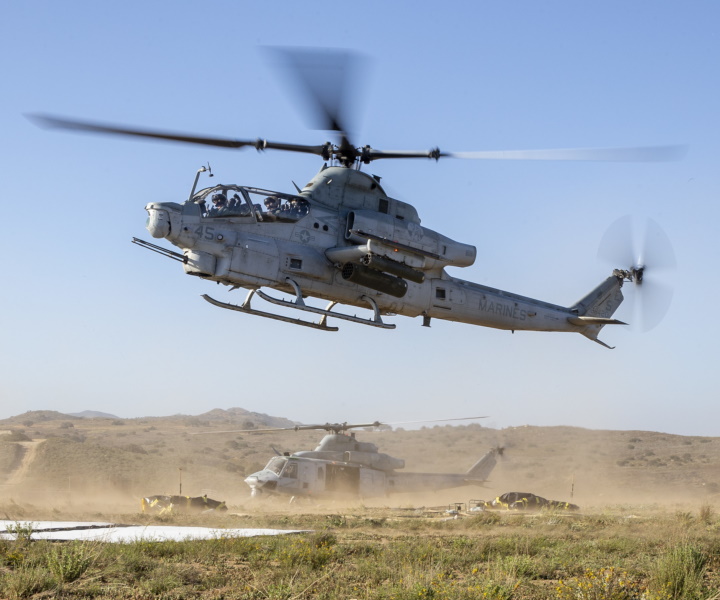
Marine Cobra crews found the improved cockpit as one of the really important features of the Zulu Cobra, since the Whiskey Cobra's cockpit was an ergonomic patchwork nightmare, making flying and fighting in the machine much more troublesome than it needed to be. The modern FLIR was also regarded as a very important feature, as was the power transmission system: the Whiskey Cobra had plenty of engine power, but its transmission wasn't sturdy enough to deal with it all and the pilot had to be careful. The Zulu Cobra didn't need such babying.
* First flight of a prototype AH-1Z was in December 2000, with initial remanufacture of operational aircraft beginning in October 2003 and deliveries ongoing. Cost of each upgrade was $11.5 million USD, and each upgrade took 13 months. That wasn't much less than the cost of a new-build machine, and so the production contract was amended to include new-build AH-1Zs.
Introduction to operational service was in late 2011, with the Marines putting a priority on deliveries to make up for a shortfall in attack helicopters. In 2018, with the Zulu Cobra fleet built up, the Marines announced that Whiskey Cobras would be phased out and sold to foreign operators. The last Marine Whiskey Cobras were retired in 2020. At least one ended up in the joint-service Picatinny Arsenal in New Jersey, flying as a test and trials machine. 189 AH-1Z Vipers were delivered to the USMC to 2022. Ironically, force cutbacks meant that, by that time, a handful of the older AH-1Zs had been retired to the aircraft "boneyard" at Davis-Monthan AFB in Arizona.
AH-1Zs in service have been getting upgrades, including:
Of course, there have been ongoing software and some general hardware upgrades -- particularly an uprated electrical power system, to support new systems and weapons. There's also been work on supporting the much-improved AIM-9X Sidewinder, and even consideration of supporting the AIM-120 Advanced Medium-Range AAM (AMRAAM) -- envisioning use of the AH-1Z as a flying anti-aircraft platform.
BACK_TO_TOP* Although the US was not eager to engage in military interventions during the post-Vietnam "hangover" in the 1970s, such interventions were resurrected during the US Reagan Administration from 1980 to 1988, and increased with a vengeance in the 1990s, with the chaos following the fall of the Soviet Union. The Cobra has been a significant weapon for such foreign expeditions:
* However, it was the Gulf War of 1991 that was the real initial test for modernized US Cobras. Both Army and Marine Cobras were major participants in the conflict. The Army committed 145 Cobras while the Marines brought in 48, with the helicopters generally fitted with engine inlet sand filters and operating from forward, dispersed sites in the desert.
Cobras destroyed hundreds of Iraqi armored vehicles and other targets in the fighting, though the Army used its more formidable AH-64 Apaches for the most intensive gunship assaults, with the Cobra relegated to the patrol and scout duties. The Marines were much more aggressive with their Cobras, in some cases using UH-1N Twin Hueys with more sophisticated FLIR systems to spot targets for the Cobras. No Cobras were shot down by the Iraqis, though two were lost in accidents during the fighting, and a third was lost in an accident afterward.
* US Cobras kept busy in the "dirty little conflicts" of the 1990s:
Marine Whiskey Cobras have continued in combat operation in the 21st century, participating in the later stages of Operation ENDURING FREEDOM, the American intervention in Afghanistan in 2001:2002, and Operation IRAQI FREEDOM, the invasion of Iraq in 2003. The Marines found the "Whiskey Cobra" to be one of the stars of the action. Marine Cobras operated in teams of two or four, maintaining a "two kilometer bubble" around the grunts. The Cobras flew with heavy armament, typically a load of four Hellfires; four TOWs; and 14 70-millimeter rockets, half with blast-fragmentation warheads, half with antipersonnel flechette warheads.
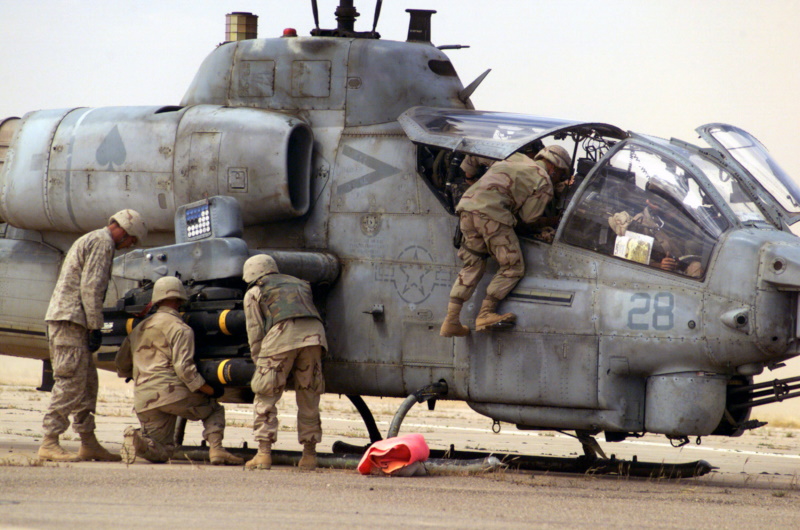
The Marines were able to use a new Hellfire variant, the AGM-114N, which had a "thermobaric" warhead, a form of fuel-air explosive (FAE) with much more explosive shock than traditional FAEs. Anti-armor Hellfires tended to go right through buildings without causing much damage, while Hellfires with blast-fragmentation warheads didn't have the kick to destroy larger structures. The AGM-114N did have the kick, one Marine saying that he shot one at a big building to take out a sniper, "and the whole building collapsed".
The Whiskey Cobras were in continuous action and were shot at a great deal. There were complaints that the M197 cannon jammed much too often, which apparently has been a long-standing problem, but overall the Marines were impressed by the survivability of the Cobra. At least two AH-1Ws were lost in combat and most were shot up to some lesser or greater extent, but Marine mechanics kept the fleet flying.
32 Army Apaches got a bloody nose at Karbala on 23:24 March 2003 when they stumbled into an Iraqi trap, with most of them shot up and two lost. There were no serious injuries to the crews, a testimony to the good protection provided by the AH-64, but the incident did help the Marines feel better about their Cobras. The Corps had long wanted to obtain Apaches but funding shortfalls always meant falling back on the old Cobra. After Karbala, the Marines could see their Cobras weren't so bad after all -- though the Karbala fiasco was generally attributed to unimaginative tactics, and not any inherent defect of the AH-64.
BACK_TO_TOP* Aside from the 202 International AH-1Js sold to Iran before the fall of the Shah, the Cobra has been obtained by a number of international buyers.
The Israelis obtained 12 AH-1Gs in 1977, and obtained further batches of later single-engine Cobra variants to bring the total to about 50. Israeli Cobras, which were locally named "Zefa (Viper)", were all updated to AH-1F configuration, and have been modified with Israeli sensors. They were also been qualified to carry the "Spike" series of antitank missiles.
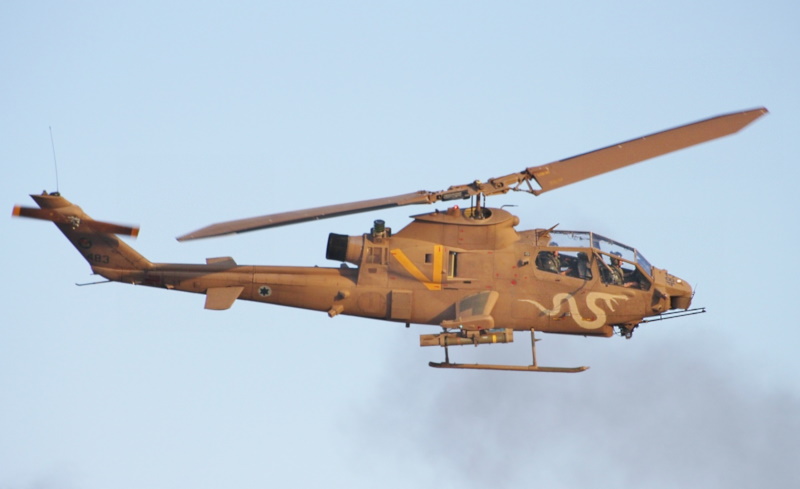
Israeli Zefas saw plenty of combat, beginning operations in Lebanon in 1979 and seeing heavy fighting in the invasion of Lebanon in 1982. Two Zefas were shot down by the Syrians, but Zefa crews claimed destruction of dozens of Syrian tanks and other targets. The Zefa later saw use in the running squabbles between the Israelis and the Palestinians. The Zefas were all retired in 2013, being replaced by the AH-64. 16 of them were refurbished and handed on to Jordan in 2015, for use by the Jordanians against Islamic State insurgents. Kenya obtained at least three as well from 2017, it appears from Jordan.
The Japanese Ground Self-Defense Force (JGSDF) bought two AH-1Es, one in 1979 and one in 1980. Following an exhaustive evaluation, license production was begun at Fuji Heavy Industries of what would turn out to be a total of 89 AH-1Fs, with Kawasaki T53-K-703 turboshaft engines. The last was delivered in 2000. The JGSDF actually retained the original "AH-1S Step 3" designation for their machines.
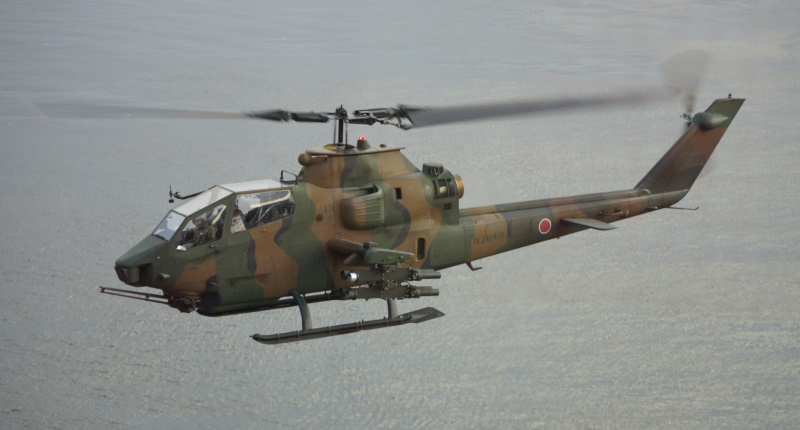
Other nations also obtained the Cobra:
In the summer of 2000, Turkey selected a slightly modified AH-1Z, given the recycled name of "KingCobra", for a helicopter gunship requirement for the Turkish Army. The contract was for an initial batch of 50 machines, but after the selection the program bogged down in quarrels between Bell and the Turkish government, and was finally canceled. The Turks eventually acquired the T129, a locally-produced version of the Agusta A129 Mangusta. In the mid-1990s, Romania tried to cut a deal with Bell for a locally-assembled Cobra variant, the "AH-1RO", but it didn't happen.
The acquisition of the Zulu Cobra by the US Marines breathed additional life into the Cobra in foreign service. While the AH-64 Apache seemed to be preferred on the export market, the relatively low cost of a Cobra upgrade made that an attractive option for nations with existing Cobra fleets.
However, following Russia's invasion of Ukraine in early 2022, it became obvious that helicopter gunships could no longer survive on the battlefield, being highly vulnerable to modern air defenses; the future belonged to drones. If the helicopter gunship has any future, it will have to be rethought. The US Marines have been evaluating "Manned Un-Manned Teaming (MUM-T)" between drones and Zulu Cobras, as well as other USMC combat assets. They have also been evaluating new munitions for the Zulu Cobra, the AIM-120 AMRAAM having been mentioned; there's also vague talk about a multirole "Long Range Attack Missile (LRAM)", said to be derived from a US Air Force munition, with a range of hundreds of kilometers,
BACK_TO_TOP* When I was down at Fort Hood, Texas, from the spring of 1973 to the late summer of 1974, I became very familiar with the Cobra. I learned to distinguish different helicopters by sound, and the Cobra had a particularly aggressive sound to it. I used to see Cobra aircrew -- lieutenants and warrant officers generally -- in the base PX, wearing flight jumpsuits with oversized cobra patches.
I was a signalman, operating the popular Canadian Marconi AN/GRC-103 telecom radio relay set. One day we were setting up, as usual on top of a hill to get a clear field of view for the antenna. We'd staked down the antenna base, and I was sitting on top of it, straddling the antenna mast and fitting the "flyswatter" antenna, when I heard the distinctive sound of a Cobra. I looked around, a little baffled since I had a clear view of the entire countryside, but I couldn't see the Cobra even though it was loud enough to be nearby. Then I looked down the hill and saw it coming up at me. In hindsight, this was a little creepy, since if it had been a real war it would have "ruined my whole day", as the saying went.
* I was surprised at how big this writeup turned out to be. If people tinker with something for 40 years, it gets a lot of history behind it. Trying to sort out all the minor variants was tricky, particularly because of the disorderly designation schemes. I used to pick on the Russians for having confusing designation schemes, but after writing this document I'll have to stop griping.
It's interesting to see how the Cobra has changed over its lifetime. The original Model 209 demonstrator was a sleek little "flying sports car", but after adding the flat-plate canopy, more formidable armament, and an array of sensors it looks a lot more like a "flying tank", while still being recognizably the same machine.

* Sources include:
* Illustrations details:
* Revision history:
v1.0 / 01 mar 01 v1.0.1 / 01 sep 02 / Review & polish. v1.0.2 / 01 sep 04 / Review & polish. v1.0.3 / 01 oct 04 / Review & polish. v1.1.0 / 01 nov 04 / Split into two chapters, general update. v1.1.1 / 01 nov 06 / Review & polish. v1.1.2 / 01 dec 08 / Review & polish. v1.1.3 / 01 nov 10 / Review & polish. v1.1.4 / 01 oct 12 / Review & polish. v1.1.5 / 01 sep 14 / Review & polish. v1.1.6 / 01 aug 16 / Review & polish. v1.1.7 / 01 jul 18 / Review & polish. v1.2.0 / 01 jun 20 / Minor updates, illustrations update. v1.3.0 / 01 jun 22 / General cleanup. v1.3.1 / 01 may 24 / Review & polish. (+)BACK_TO_TOP
